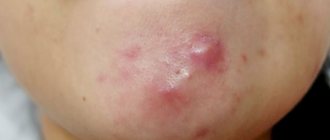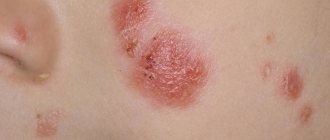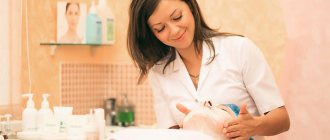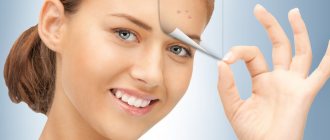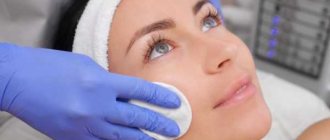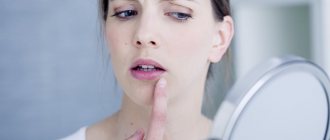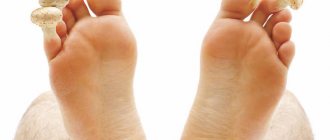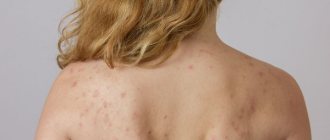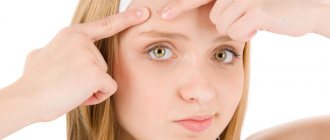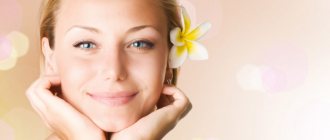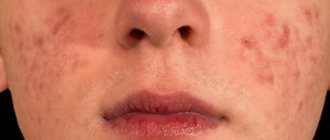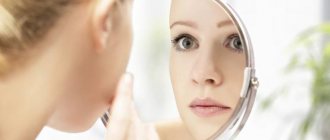Acne on the body is considered not the most pleasant phenomenon and can appear at any age. The cause of rashes can be various pathologies of internal organs and hormonal imbalances, as well as non-compliance with personal hygiene rules.
Most often, the question of how to get rid of acne on the body concerns teenagers who are especially sensitive to the appearance of their skin. Treatment of acne on the face requires an integrated approach, so it is unlikely that it will be possible to quickly solve the problem.
Types of acne on the body
Acne is divided into two categories - without signs of inflammation and inflammatory. The first include:
- blackheads, or open comedones;
- white, or closed, comedones.
More often on the body there are inflammatory elements of the rash, namely:
- papules - cavityless red nodules with a diameter of 0.3 to 3 cm;
- ulcers or pustules - superficial or deep pimples with purulent accumulations;
- bubbles are spherical elements with bloody or translucent contents.
After acne resolves, secondary elements of the rash remain on the skin - pigment spots, scabs, fishnets, erosions, scales, etc.
Physiotherapy
The following most effective methods are used as physiotherapy for persistent acne:
- laser therapy;
- electrocoagulation;
- phototherapy.
Laser therapy is one of the effective methods
The above methods are the most popular and effective. The procedures have approximately the same principle of effect on the skin.
They increase local immunity by improving microcirculation in blood vessels. Due to this, more nutrients are supplied to the epidermal cells, they are better saturated with oxygen, and stagnant processes caused by pathogenic bacteria are eliminated. Due to this effect, local inflammation is relieved and the regeneration process starts.
Despite the many positive aspects of physiotherapy and their relative safety, they have a large number of contraindications. The use of physiotherapy is not permissible for neoplasms of various etiologies, hemophelia, and infectious diseases. Before their appointment, the patient must undergo the recommended examination.
Causes of acne on the body
Body acne is a chronic skin disease caused by inflammation of the sebaceous glands. It is caused by Propionibacterium acnes, the propionic acne bacterium. Acne occurs in 65-80% of people aged 12 to 30 years. Approximately 1/3 of them require therapeutic treatment.
Before you start getting rid of acne, it is necessary to determine their cause, since the success of treatment directly depends on whether the provoking factor has been eliminated.
The disease is provoked by various reasons, the identification of which facilitates the choice of treatment methods. Excessive sebaceous production, proliferation of the stratum corneum, and proliferation of bacteria play a decisive role in the formation of ulcers.
Improper body care
If small pimples appear on the body, in 40% of cases this indicates non-compliance with the sanitary and hygienic regime. The accumulation of secretions from the sebaceous and sweat glands in the skin pores is fraught with the proliferation of pathogenic flora.
The causes of pimples on the torso and limbs include:
- use of low-quality cosmetics – shower gels with preservatives and parabens;
- contact with clothing - synthetics, viscose, polyester, acrylic;
- infrequent showering - less than 1 time per day;
- bathing too often - more than 4 times a day.
Both excessive and insufficient cleanliness create conditions for the proliferation of pathogenic bacteria.
Allergic reactions
Small pimples on the body of an adult occur due to allergies to external irritants. Provocateurs of inflammation include:
- hygiene products – shower gels, foams, shampoos;
- cosmetics – creams, body milk;
- synthetic fabrics - supplex, polyester, nylon, polyamide;
- food products – honey, whole milk, egg whites, mushrooms.
Autoimmune disorders often lead to acne. But when the provoking factors are eliminated, hard pimples resolve over time.
Infectious and parasitic diseases
In 36% of cases, an inflamed pimple is the result of diseases of parasitic or infectious origin. Penetrating into the skin, pathogenic microorganisms begin to multiply. Their waste products are toxic and cause inflammation, causing red or white pimples to appear on the body.
Diseases that cause acne include:
- demodicosis;
- helminthic infestations;
- pyoderma;
- follicular hyperkeratosis;
- rosacea;
- impetigo;
- seborrheic dermatitis;
- staphylococcal infection;
- furunculosis.
Purulent large pimples are a consequence of the proliferation of corynebacteria, propionibacteria, streptococci, yeast-like fungi, etc. in the skin.
Endocrine disorders
The first acne occurs during puberty due to an increase in the level of steroid hormones in the blood. Internal acne after 19-20 years becomes a consequence of endocrine disruptions. In women, ulcers occur due to hormonal imbalance. Provocateurs of endocrine disorders include:
- polycystic ovary syndrome;
- pregnancy;
- abortions;
- menses;
- menopause
In men, acne occurs due to an increase in the concentration of testosterone in the blood. Fluctuations in hormonal levels are often caused by pathologies of the pituitary gland and gonads.
Atopic dermatitis and eczema
The cause of the blistering rash is atopic dermatitis. The disease is characterized by a wave-like course with exacerbations in the cold season.
A common cause of acne on the body can be ordinary dirt and sweat. They say that cleanliness is the key to health. This expression is also true for the skin.
Provoking factors include:
- psycho-emotional stress;
- autoimmune disorders;
- disruption of biochemical reactions in the skin.
If dry pimples appear on the body, this indicates eczema. Typical manifestations of non-communicable pathology include:
- skin itching;
- redness;
- point erosion;
- blistering rashes.
Acne is caused by chemical and thermal effects, gastrointestinal pathologies, mental disorders, kidney dysfunction, etc.
Diseases of internal organs
Deterioration of the skin condition is a consequence of disturbances in the functioning of vital organs. Inflammatory elements occur when there is a malfunction of:
- thyroid gland;
- liver;
- pituitary gland;
- kidney;
- intestines.
Acne on the body in men and women is formed against the background of dysbacteriosis, diabetes mellitus, liver failure, frequent constipation, pyelonephritis, etc.
Pemphigus
Pemphigus, or pemphigus, is a potentially fatal disease of autoimmune origin. It affects not only the skin, but also the mucous membranes. Accompanied by the formation of blistering rashes. As the disease progresses, acne appears throughout the body.
The cause of pemphigus is the body's production of aggressive antibodies to the protein components of skin cells and mucous membranes. The disease is difficult to treat. The risk of infectious inflammation of the vesicles is very high.
Hemorrhagic vasculitis
Rheumatic purpura, or hemorrhagic vasculitis, is accompanied by non-infectious inflammation of the superficial vessels in the skin and internal organs. The disease is of allergic origin and usually ends with spontaneous recovery. With vasculitis, red blisters filled with fluid mixed with blood appear on the body. The first rash is usually localized on the legs, then affects the thighs and buttocks.
Rare causes
The success of acne therapy depends on the correct identification of provoking factors. Possible causes of acne on the torso and limbs include:
- hirsutism in women;
- blood diseases;
- systemic mycoses;
- photodermatitis;
- chickenpox;
- scabies;
- avitaminosis.
Abuse of chemical peeling also leads to damage to the protective layer of the epidermis and inflammation of the follicles. Sometimes acne on the forearms and back is formed due to poor nutrition, taking contraceptives, and alcohol.
Retinoids
This group of drugs is often prescribed when nothing helps to cope with acne. Sufficiently powerful medications can effectively cope with rashes, as well as furunculosis. Retinoids include:
- "Roaccutane";
- "Sortret";
- "Aknekutan."
Roaccutane is prescribed from 12 years of age
Oral medications require long-term treatment, which should continue for several months. Good therapeutic results can sometimes be noticed no earlier than six months later.
Therapy should be carried out under the strict supervision of a specialist, since retinoids often lead to negative reactions. It is especially important to regularly take tests to help monitor blood composition.
Drugs in this group are not suitable for everyone, as they have a large list of contraindications, the absolute ones of which are pregnancy, lactation, and severe disorders of the kidneys and liver.
How to diagnose the cause
Only an experienced specialist - a dermatologist or dermatovenerologist - can determine the true cause of acne. Acne is diagnosed based on the symptomatic picture - multiple ulcers, redness around them, post-acne.
To identify the factors that caused acne, the doctor prescribes:
- general blood analysis;
- coprogram;
- blood test for hormones;
- Ultrasound of the thyroid gland;
- allergy test;
- analysis for demodex.
When making a diagnosis, the dermatologist excludes other diseases - urticaria, rosacea, pemphigus, allergies, etc. If acne is caused by hormonal imbalances or diseases of the reproductive system, you will need to consult an endocrinologist, gynecologist or urologist.
Diet therapy
Proper nutrition is the key to good health and healthy skin. Junk food clogs the body from the inside, preventing it from absorbing vitamins, minerals, amino acids and other substances. Instead, a large amount of poisons and toxins accumulate in the intestines, which leave the body not only through the main excretory systems, but also through the skin. As a result, both local and general immunity is weakened, leading to inflammatory processes in the dermis.
Nutritional correction is also included in therapy
Eliminating the following products from the diet will help launch a faster process of integument regeneration:
- spicy dishes;
- fried food;
- smoked meats;
- fat meat;
- fast food;
- confectionery baked goods;
- semi-finished products;
- alcohol.
In case of severe acne, these products should be completely banned and permanently excluded from the diet.
The patient must be provided with a correct and complete diet, including products that help eliminate waste and toxins from the body. Such products include all vegetables, herbs, berries, fruits, fish, cereals, whole grains and dairy products without exception. In addition to cleansing the body, they will provide all important systems with necessary nutrients and strengthen the immune system.
How to get rid of acne on the body
For mild to moderate acne, therapy is carried out at home. It is aimed at reducing sebum secretion, eliminating inflammation, healing tissue and preventing new elements of the rash.
To combat acne, pharmaceutical drugs, medicinal cosmetics, physiotherapeutic procedures, and diet are used. Post-acne is eliminated using hardware methods - mechanical peeling, dermabrasion, phototherapy.
Body care
The likelihood of pimple formation depends on the regularity of water treatments and the quality of hygiene cosmetics. To prevent blockage of the sebaceous ducts with fat, you must:
- take a bath or shower in the morning and evening;
- dry the skin after water procedures;
- Wash with a washcloth once every 2-3 days;
- use cosmetic oil or body milk.
Intensive hydration restores the skin's hydrolipid mantle and prevents the penetration of bacteria into it. To eliminate acne and speed up their healing, you need to take a bath with chamomile, calendula or string once every 3-4 days.
Nutritional Features
It is impossible to cure acne without following the basic principles of nutrition. The speed of metabolism in the skin and the activity of the sebaceous glands depend on the quality of the products. To prevent excess sebum secretion, you need to include in your diet:
- flax seeds;
- lean fish;
- broccoli;
- pumpkin;
- celery;
- green tea;
- kefir;
- homemade yogurt;
- green beans;
- oats;
- raspberries;
- carrot;
- dried fruits.
During treatment, it is advisable to avoid eating foods with a high glycemic index - sweets, white bread, chips, cookies. You also need to limit your consumption of sugar, salt, and whole milk.
Medicines
Treatment of acne on the body involves local therapy with antimicrobial, wound healing and antiseptic agents. To eliminate acne use:
- Zinerit is an antibacterial drug with erythromycin, which has an antiseptic, wound-healing and anti-inflammatory effect;
- Skinoren is a gel with azelaic acid that normalizes the exfoliation of skin cells;
- Baziron AC is an acne treatment based on benzoyl peroxide, which suppresses the production of sebum and the proliferation of bacteria in the skin;
- Effezel - a gel with adapalene that eliminates acne, inflammation and flaking of the skin;
- Oxygel is an antiseptic and exfoliating agent that prevents the formation of acne on the body.
Also, to combat acne, it is recommended to purchase antiseptic solutions of hydrogen peroxide, boric and salicylic acid at the pharmacy.
Traditional methods
Alternative medicine products are not able to get rid of acne forever, but with regular use they prevent breakouts on the body. Infusions and decoctions of the following herbs have pronounced anti-acne properties:
- chamomile;
- celandine;
- Oak bark;
- calendula;
- motherwort;
- horsetail;
- big plantain.
To prepare body lotion, you need to pour 2 tbsp. l. raw materials 1 liter of water and boil for 5 minutes. Moisten a cotton pad in the strained broth and wipe acne on the body immediately after water procedures. Repeat the procedure 2-3 times a day.
Nutrition for acne
There is no need to explain how important proper nutrition is for acne and bad skin. It is necessary to carefully consider the daily menu, including as many fiber-rich vegetables and fruits as possible, trying to limit heavy foods rich in simple carbohydrates and saturated fats.
Photo 32 - Eat less fried food
Menu for the week based on morning, lunch, evening: First day:
- Oatmeal or oat porridge, vegetable salad or fresh fruit.
- Vegetable or chicken soup, eggs, fresh vegetable or fruit.
- Slaves or steamed cutlets, vegetable salad dressed with butter, black bread.
Photo 33 – Oatmeal for breakfast is very healthy
Second day:
- Cheese, berry juice or scrambled eggs.
- Low-fat soup, 100 gr. boiled beef, mostly green tea.
- Stewed vegetables, boiled chicken meat.
Photo 34 - Boiled meat is healthier than fried meat
The third day:
- Fruit salad, unsweetened compote or juice.
- Fresh vegetable salad, boiled rabbit meat or rabbit meat soup, unsweetened tea.
- Boiled buckwheat, fermented baked milk or kefir.
Photo 35 – Eat more fresh vegetables
Fourth day:
- Millet porridge with little or no sugar, fresh fruit, green tea.
- Boiled turkey meat, soup based on it and salad.
- Boiled veal, vegetable salad or stewed vegetables, tea or compote without sugar.
Photo 36 – Consume less sugar
Fifth day:
- Low-fat cottage cheese, kefir or fermented baked milk, fresh fruit.
- Barley or soup with it, boiled chicken breast, compote.
- Fresh fruit or vegetable salad, cheese, green tea.
Photo 37 - Eat low-fat dairy products
Sixth day:
- Boiled egg, vegetable salad with lemon juice, rosehip infusion.
- Boiled fish, fish soup, black bread with cheese.
- Boiled buckwheat, fruit jelly.
Photo 38 - Black bread is healthier than white bread
Seventh day:
- Boiled millet without sugar, dried fruit compote.
- Chicken and vegetable soup, salad dressed with butter, black bread.
- Low-fat cottage cheese, boiled fish, compote or jelly.
Photo 39 - Dried fruit compotes are healthier than tea or coffee
Many people wonder: is it possible to eat honey, since sugar is practically prohibited in such a diet? Honey can be eaten in small quantities (1-2 teaspoons per day). However, this should not be abused.
Photo 40 – Honey can be eaten 1-2 teaspoons per day
Attention! For skin problems, vegetarianism or limiting your intake of hard-to-digest animal protein and saturated fats can help.
What can be dangerous about a systemic rash?
Acne is not life-threatening. But pimples on the body are often symptoms of more severe pathologies. The prognosis depends on the cause of inflammation of the sebaceous glands and disruption of biochemical reactions in the skin.
Bacterial infections pose a serious health threat. Their delayed treatment is fraught with:
- boils;
- boils;
- carbuncles;
- abscesses;
- sepsis;
- lymphadenitis.
Also, acne all over the body is a symptom of hemorrhagic vasculitis. The disease is fraught with dysfunction of the peripheral and central nervous systems.
Antibiotics
Therapy with antibacterial drugs sometimes helps to cope very effectively with a dermatological disease when local drugs do not bring the desired effect. The following antibiotics may be prescribed for oral administration:
- "Erythromycin";
- "Tetracycline";
- Unidox Solutab.
Recommended Antibiotics
The drugs can effectively suppress the pathogenic activity of pathogenic bacteria and relieve inflammation from the lesions. These antibiotics are contraindicated to be taken simultaneously with retinoids due to the reduced effectiveness of the drugs.
The minimum course of treatment with antibiotic therapy is 1-1.5 months. After treatment with antibiotics, the patient is required to be prescribed probiotic therapy to restore beneficial intestinal microflora.
Ignoring this point in treatment can lead to relapse of the dermatological disease.
How to prevent rashes
Acne is difficult to cure, as it is provoked by many external and internal factors. To prevent acne, you must:
- observe sanitary and hygienic regime;
- wear clothes made from natural fabrics;
- eat rationally;
- to refuse from bad habits;
- avoid stressful situations;
- treat dysbacteriosis and skin infections in a timely manner;
- treat injuries on the body with antiseptics;
- Take a bath with herbal infusions 1-2 times a week.
If acne has already appeared, changes in the skin become irreversible. It is impossible to achieve a complete cure even with the use of medications. But compliance with preventive measures and treatment of current diseases prevent the formation of ulcers on the body.
Folk remedies
Traditional medicine will also help against acne. However, you must first cure the disease that provokes their appearance.
Photo 48 - Traditional medicine fights acne
Treatment with folk remedies for skin diseases may include: cleansing masks made from clay, oatmeal, kefir and cucumber.
Photo 49 – Clay mask
You can treat acne with herbs that have antibacterial properties, as well as aloe juice lotions. Post-acne can be treated well with ordinary bodyagi.
Photo 50 - Aloe will help with acne
Attention! Treatment methods for acne on the face are unique and require prior approval from a specialist.
